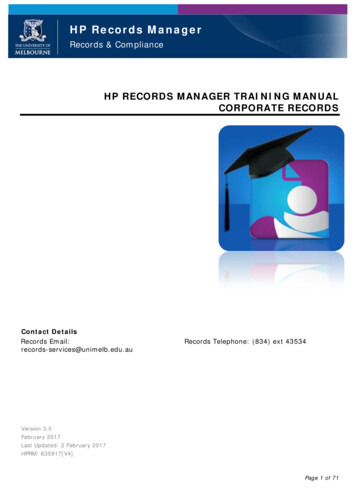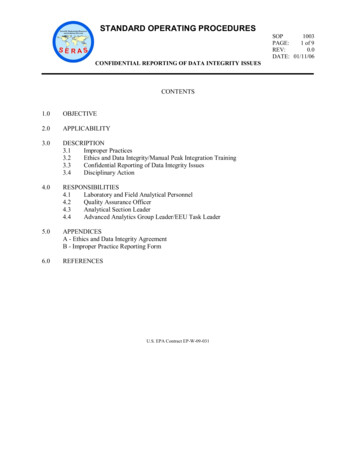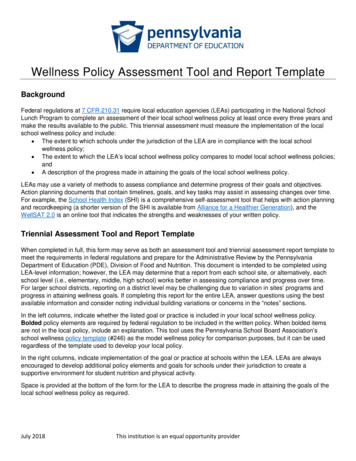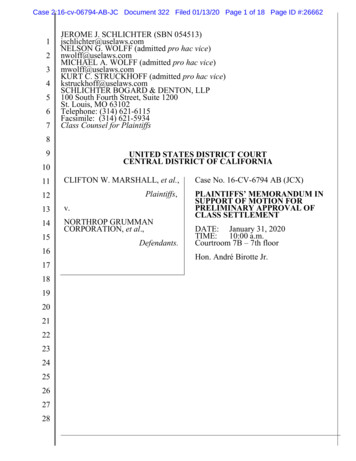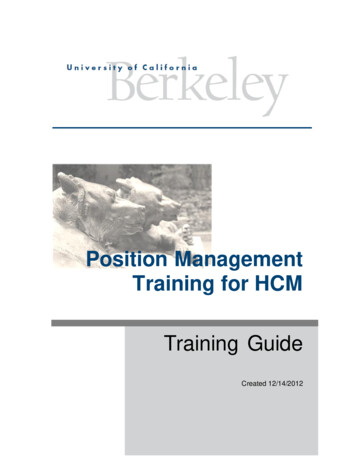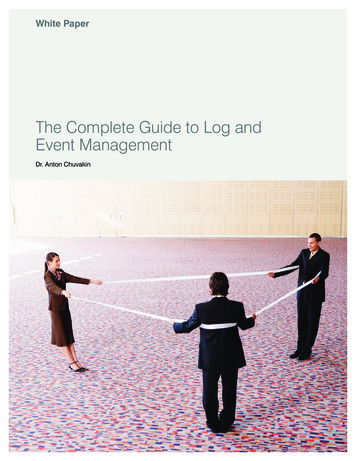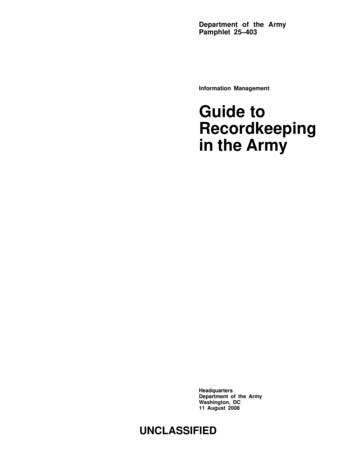
Transcription
Department of the ArmyPamphlet 25–403Information ManagementGuide toRecordkeepingin the ArmyHeadquartersDepartment of the ArmyWashington, DC11 August 2008UNCLASSIFIED
SUMMARY of CHANGEDA PAM 25–403Guide to Recordkeeping in the ArmyThis rapid action revision, dated 11 August 2008-oRe-establishes DA Form 1613, Records Cross Reference (fig 3-1).oUpdates paragraph to reference DA Form 1613 (para 3-3b).oReplaces Figure 3-1 with a sample DA Form 1613 (para 3-3b).oMakes administrative changes (throughout).
*Department of the ArmyPamphlet 25–403HeadquartersDepartment of the ArmyWashington, DC11 August 2008Information ManagementGuide to Recordkeeping in the ArmyGuard/Army National Guard of the UnitedStates, and the U.S. Army Reserve, unlessotherwise stated. During mobilization,procedures in this publication can bemodified to support policy changes asnecessary.History. This pamphlet is a rapid actionrevision. The portions affected by thisrapid action revision are listed in thesummary of change.Summary. This pamphlet provides operational procedures and guidelines forrecordkeeping within the Army. It is to beused with AR 25–400–2.Applicability. This pamphlet applies tothe Active Army, the Army NationalContentsProponent and exception authority.The proponent of this pamphlet is the Administrative Assistant to the Secretary ofthe Army. The proponent has the authority to approve exceptions or waivers tothis pamphlet that are consistent with controlling law and regulations. The proponent may delegate this approval authority,in writing, to a division chief within theproponent agency or its direct reportingunit or field operating agency, in thegrade of colonel or the civilian equivalent.Activities may request a waiver to thispamphlet by providing justification thatincludes a full analysis of the expectedbenefits and must include formal reviewby the activity’s senior legal officer. Allwaiver requests will be endorsed by thecommander or senior leader of the requesting activity and forwarded throughhigher headquarters to the policy proponent. Refer to AR 25–30 for specificguidance.Suggested improvements. Users areinvited to send comments and suggestedimprovements on DA Form 2028 (Recommended Changes to Publications andBlank Forms) directly to the Office of theAdministrative Assistant to the Secretaryof the Army (JDRP–RDR–R), 7701 Telegraph Road, Alexandria, VA 22315–3860.Distribution. Distribution of this pamphlet is available in electronic media onlyand is intended for command levels A, B,C, D, and E for the Active Army, theArmy National Guard/Army NationalGuard of the United States, and the U.S.Army Reserve.(Listed by paragraph and page number)Chapter 1Introduction, page 1Purpose 1–1, page 1References 1–2, page 1Explanation of abbreviations and terms 1–3, page 1Prescribing directive 1–4, page 1Statutory authority 1–5, page 1Functions 1–6, page 1Application of the Army Records Information Management System Program 1–7, page 2Principles and concept of the Army Records Information Management System 1–8, page 2The Army Records Information Management System software application 1–9, page 6Office records lists 1–10, page 6Maintaining records for multiple organizations 1–11, page 7Maintaining records in libraries 1–12, page 7*This pamphlet supersedes DA Pam 25–403, dated 20 December 2006.DA PAM 25–403 11 August 2008UNCLASSIFIEDi
Contents—ContinuedChapter 2Identifying Records and Recordkeeping Requirements, page 7Records 2–1, page 7Non–records 2–2, page 9Personal records 2–3, page 9Vital records 2–4, page 10Unscheduled and unidentified records 2–5, page 11Contractor records 2–6, page 11Special records collections 2–7, page 11Contingency operations records 2–8, page 11Records of defunct Army commands 2–9, page 12Records of Joint staff and combatant commands 2–10, page 12Records life cycle 2–11, page 12Recordkeeping requirements 2–12, page 12Chapter 3Managing the Various Types of Records Media, page 14Section IHardcopy records, page 14General 3–1, page 14Records preparation before filing 3–2, page 14Cross references 3–3, page 14File supplies 3–4, page 16Arrangement of files 3–5, page 16Classified documents 3–6, page 21Suspense files 3–7, page 21Labeling 3–8, page 21Storing 3–9, page 24Micrographic records 3–10, page 25X–Ray film records 3–11, page 25Visual information 3–12, page 26Cartographic and architectural records 3–13, page 26Section IIElectronic records, page 26General 3–14, page 26Electronic mail 3–15, page 27Information systems 3–16, page 27Automated office applications 3–17, page 29Image (bit–mapped) files 3–18, page 29Web pages 3–19, page 30Judicial use of electronic records 3–20, page 31Managing records on electronic media 3–21, page 31Labeling 3–22, page 32Use of optical media 3–23, page 33Chapter 4Applying Disposition Instructions, page 34Disposition 4–1, page 34Records value 4–2, page 34Retention periods 4–3, page 34Record cutoffs 4–4, page 36Disposition instructions 4–5, page 36Records created during mobilization 4–6, page 37iiDA PAM 25–403 11 August 2008
Contents—ContinuedRecommended changes to record descriptions, record numbers and disposition instructions 4–7, page 37Chapter 5Scheduling Records, page 38Scheduling 5–1, page 38Scheduling process 5–2, page 38General records schedules 5–3, page 39Web records 5–4, page 39Chapter 6The Army Records Information Management System (ARIMS) Web Site, page 39General 6–1, page 39System components 6–2, page 40System requirements 6–3, page 40Security 6–4, page 40Army Records Information Management System components/modules 6–5, page 40Home page introduction 6–6, page 40Records Retention Schedule–Army 6–7, page 40Registration 6–8, page 41Records management–assistance 6–9, page 41Records Input Processing System 6–10, page 42Master index 6–11, page 44Electronic capture and store 6–12, page 44Backfile indexing 6–13, page 44Chapter 7Records Transfer and Retirement, page 44General 7–1, page 44When to retire 7–2, page 44Hardcopy records 7–3, page 44Electronic records 7–4, page 45Preparing hardcopy records for transfer or retirement 7–5, page 46Classified records 7–6, page 47For Official Use Only records 7–7, page 48Transferring records to other organizations 7–8, page 48Preparing the SF 135 7–9, page 48Packing the boxes 7–10, page 50Numbering boxes for shipment 7–11, page 51Shipment of boxes 7–12, page 51Preparing the SF 258 7–13, page 52Chapter 8Reference Procedures and Services, page 53Army Records Information Management System master index of retired records 8–1, page 53Records retrieval 8–2, page 53Records holding area records reference services 8–3, page 54Requesting reference service from Federal records centers 8–4, page 54Relocation of records within a Federal records center 8–5, page 55Other services offered by Federal records centers 8–6, page 55Chapter 9Records Disposition, page 56Disposition 9–1, page 56Records disposal 9–2, page 56Records freezes or moratoriums 9–3, page 56DA PAM 25–403 11 August 2008iii
Contents—ContinuedDeviations from disposition instructions 9–4, page 56Disposition of records on change of status 9–5, page 57Unauthorized destruction, damage, or removal of records or accidental destruction 9–6, page 57Destruction as result of international armed conflict or threatened war 9–7, page 58Disposition of records that are a menace to human life, health, or property 9–8, page 58Notification of pending disposition 9–9, page 58Disaster recovery of records 9–10, page 58Damaged records 9–11, page 59Deleted/lost electronic records 9–12, page 60Chapter 10Records Holding Areas and Federal Records Centers, page 60Regional and overseas records holding areas 10–1, page 60Establishing records holding areas 10–2, page 60Operation of records holding areas 10–3, page 60Discontinuance of records holding areas 10–4, page 61Army records centers 10–5, page 61National Archives and Records Administration Federal records centers 10–6, page 61Chapter 11Records Management Program Evaluations, page 61General 11–1, page 61Evaluation objectives 11–2, page 61Scheduling the evaluation 11–3, page 61Notification 11–4, page 61Entrance briefing 11–5, page 62Evaluation process 11–6, page 62Exit briefing 11–7, page 63Written report of findings and recommendations 11–8, page 63Evaluation questions 11–9, page 63Chapter 12Contingency Operation Record Collection and Preservation, page 63Background 12–1, page 63Explanation of responsibilities 12–2, page 63Collection guidance 12–3, page 63Unit assistance 12–4, page 67AppendixesA.References, page 68B.Records Management Program Evaluation, page 73C.Quick Reference Guide to Documenting Operations for Deployed Units of the Army, page 76Table ListTableTableTableTableTableTableiv1–1.: Prescribing Directive Functional Categories, page 36–1: Container types and uses, page 436–2: Storage capacities for hardcopy records, page 436–3: Conversion factors from linear feet to cubic feet, page 437–1: Restriction codes, page 5012–1: Operational records1, page 64DA PAM 25–403 11 August 2008
Contents—ContinuedFigure ��1: Relationship between file numbers and prescribing directive, page 62–1: Life cycle of a record, page 92–2: Sample “Appendix B–Recordkeeping Requirements (AR 215–4)”, page 133–1: Sample DA Form 1613, Records Cross Reference, page 153–2: Sample use of guide cards, page 163–3: Sample date arrangement of documents within a folder, page 173–4: Sample subject arrangement of files with a record series, page 173–5: Sample personal names arrangement of files, page 183–6: Sample place names arrangement of files, page 183–7: Sample organization names arrangement of files, page 193–8: Sample numeric arrangement of files, page 203–9: Sample alphanumeric arrangement of files, page 203–10: Sample file and barcode labels, page 223–11: Sample label entries and use of “dummy” folder, page 233–12: Sample file container and binder label entries, page 243–13: External disk label, page 324–1: Sample time and event dispositions, page 374–2: Sample time–event dispositions, page 377–1: Sample SF 135 transferring unscheduled records, page 477–2: Sample detailed folder listing, page 497–3: Types of boxes and supplies required for records transfer, page 5112–1: Sample SF 135 of transferring CONOPs records, page 67C–1: Records preservation list, page 78C–1: Records preservation list—Continued, page 79GlossaryDA PAM 25–403 11 August 2008v
Chapter 1Introduction1–1. PurposeThis pamphlet provides the procedures for implementing policy contained in AR 25–400–2. It provides operationalprocedures for the maintenance and disposition of Army information, which encompasses identifying records, managing the various types of records media, applying disposition instructions, scheduling records, using the Army RecordsInformation Management System (ARIMS) software application, transferring and retiring records, and referencing andservicing procedures; this pamphlet also explains records disposition, records holding areas (RHAs), Federal recordscenters (FRCs), and records management program evaluations. This guide specifically addresses those duties performedby the records management officials in dealing with the recordkeeping subprogram of the Army records managementprogram.1–2. ReferencesRequired and related publications and prescribed and referenced forms are listed in appendix A.1–3. Explanation of abbreviations and termsAbbreviations and special terms used in this pamphlet are explained in the glossary.1–4. Prescribing directiveArmy Regulation (AR) 25–400–2 governs the maintenance and disposition of Army information and provides policyon managing information from its creation through final disposition according to Federal laws and Army recordkeepingrequirements. The ARIMS Web site at https://www.arims.army.mil provides tools to facilitate carrying out theserequirements. A username and password are required to log in to the ARIMS Web site (see para 6–1c, below, for logininstructions).1–5. Statutory authoritya. The Federal Records Act of 1950, as amended, contains the statutory authority for the ARIMS program.Government–wide responsibility for Federal recordkeeping is shared by the General Services Administration (GSA)and the National Archives and Records Administration (NARA).b. Sections 3301 through 3314, Title 44 United States Code (44 USC 3301 through 44 USC 3314), establishes thelegal basis for the disposal of records of the U.S. Government.c. The Paperwork Reduction Act, 44 USC, Chapter 35, establishes the legal basis for minimizing the cost ofcreation, collection, maintenance, use, dissemination, and disposition of information.1–6. FunctionsThis paragraph provides additional information not included in the records official’s responsibilities outlined in AR25–400–2, para 1–4 and AR 25–1, chapters 2 and 8.a. Records administrators (RAs). Under ARIMS, the RA has the ability to—(1) Create, modify, and approve Office Records Lists (ORLs) for all units within the Army Command (ACOM),Army Service Component Command (ASCC), or Direct Reporting Unit (DRU) he/she supports.(2) View all records for every unit within the ACOM, ASCC, or DRU.(3) Process all requests for hardcopy official records and/or access to electronic records under his/her responsiblearea when necessary.b. Records managers (RMs). The RMs may serve at the Headquarters, Department of the Army (HQDA) level,major subordinate command level, field operating agency, DRU, separately authorized activities, tenant organizations,satellite organizations, U.S. Army Installation Management Command (IMCOM) regional levels, and on installationgarrison staff with command–wide or organization–wide records management responsibilities. Many of the ArmyRHAs are also staffed with RMs. RMs—(1) Approve ORLs for subunits.(2) Serve as local authority for recordkeeping subprogram procedures/issues.(3) Manage, oversee, and direct the command, agency, or installation recordkeeping subprogram.(4) Survey and appraise the agency, command, or installation recordkeeping subprogram at least once every 3 years.(5) Prescribe and ensure necessary corrective action is taken as part of the complete records management program.(6) Manage and provide staff direction for the operation of the RHA.(7) Ensure records are properly arranged and packed prior to movement from the RHA to an FRC.(8) Maintain liaison and coordinate records transfer, retirement, and retrieval with the FRCs and local NARAoffices.c. Records coordinators (RCs). The RCs are designated at sub–elements as necessary for program execution. Theymay—DA PAM 25–403 11 August 20081
(1) Develop ORLs for their unit.(2) Coordinate retirement of transfer (T) records to the RHA.(3) Serve as the subject matter expert for the unit’s records.(4) Resolve indexing problems with the RHA.(5) Ensure implementation of recordkeeping procedures throughout their unit.d. Action officers (AOs) at all levels of command. An AO is any individual who creates official records on behalf ofthe Army. The AO has the capability to—(1) Search the Army’s office record instructions to help determine if a document is an official record.(2) Create a draft ORL to be maintained for each office symbol within a unit or organization.(3) Submit records to the Army electronic archives (AEA) or designated records holding facility.(4) Search for and request records in ARIMS.(5) View all records submitted to ARIMS internal to the unit.(6) Identify records as keep (K) (short–term) or T.(7) Register in ARIMS and submit e–records via the electronic capture and store (ECS) module.e. NARA. The NARA is the oversight agency responsible for appraising all Federal records, approving theirdisposition, providing program assistance and FRC storage, evaluating records management programs, and serving asthe final custodian of permanent records. The NARA operates 2 different types of records facilities.(1) FRCs. These centers provide temporary storage and reference service for records that are needed infrequently bythe creating agency, but are not yet eligible for disposal or transfer to The National Archives. Army records stored inan FRC remain in the legal custody of the Army.(2) The National Archives. The National Archives store the Federal Government’s permanent records, which arealso known as The National Archives of the United States. When transferring permanent records to The NationalArchives, agencies also transfer legal and physical custody of the records. The National Archives takes conservationmeasures needed to preserve the records and also provides reference service, including service to the creating agency.f. Service providers. To achieve efficiency and to maximize use of Army resources, the functions described in thispamphlet may be performed by a contractor or other agency through memorandum of agreement, memorandum ofunderstanding, and so on. However, the organization maintains responsibility for its records.1–7. Application of the Army Records Information Management System Programa. The ARIMS applies to—(1) All unclassified Army record information, including For Official Use Only (FOUO), regardless of format ormedium (paper, electronic ((electronic mail (e–mail), information system data files/databases, word processing,bit–mapped)), microfilm, and so on).(2) All classified Army record information through secret. Records that are top secret may be set up under ARIMSor in any other manner that will make accountability and control easier. Regardless of the arrangement used, however,the disposition instructions in the ARIMS Records Retention Schedule–Army (RRS–A) will be applied to top secretrecords. The security classification of a record does not change its retention value.b. The ARIMS does not apply to—(1) Record copies of international agreements covered under AR 550–51 (except those maintained by the Office ofThe Judge Advocate General).(2) Publications and blank forms stocked for filling requisitions.(3) Reference materials and books in formally organized and officially designated libraries.(4) Personal or private records maintained in the workplace.(5) Duplicate copies of documents maintained in the same file.1–8. Principles and concept of the Army Records Information Management Systema. Under the ARIMS, records are identified according to the primary directive that prescribes those records becreated, maintained, and used. One only needs to know what the prescribing directive is for a specific program tolocate the record/file numbers that should be applied to records created to support that program. For example, recordscreated to support the ARIMS program would have their numbers based on AR 25–400–2 because that is theprescribing directive for the ARIMS program. For the most part, the record numbers (RNs) are based on an Armyregulation number; however, in the absence of an AR, the number may be based on a Department of the Army (DA)pamphlet, engineering regulation, or some other directive. If no directive can be pinpointed, the number is based on thefunctional category number under which the program falls (for example, 25 for information management, 40 formedical, and so on). See table 1–1, below, for the prescribing directive functional categories and figure 1–1, below, forthe relationship between file numbers and prescribing directives. Only RNs listed in the ARIMS RRS–A are authorizedfor use.2DA PAM 25–403 11 August 2008
Table 1–1.Prescribing Directive Functional CategoriesSeriesFunctional categorySeriesFunctional category381Military Real Estate10Organization and Functi
The Army Records Information Management System software application † 1–9, page 6 Office records lists † 1–10, page 6 Maintaining records for multiple organizations † 1–11, page 7 Maintaining records in libraries † 1–12, page 7 *This pamphlet supersedes DA Pam 25–403,



